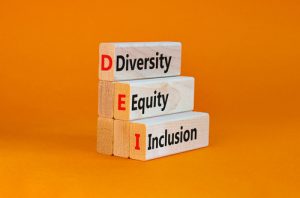The decision to “implement DEI practices” is sometimes viewed as a quick and definitive response to addressing the needs of an organization. However, for many organizations, implementing DEI as a “solution” requires support from leadership and an intentional approach based on a collective effort. Or to say it a little differently, implementing DEI requires strong leadership support, a clear strategy, and shared accountability. 
Championing and supporting DEI work should never rest as the primary responsibility of a single person or team within the organization. Instead, implementing DEI often first requires taking a step back and objectively assessing where your organization is in your DEI journey, unpacking each of those elements–diversity, equity, and inclusion and creating a practical, actionable definition of what each of these interrelated terms means in the broader business context as well as specifically within your organization.
Get Started
A good place to start is assessing the current situation, managing expectations, and asking essential questions. In terms of expectations; it cannot be stated enough that implementing DEI practices is not a single action or simple solution. It should not be viewed as a panacea but rather as a complex web of issues, opportunities, and responses within organizations that require their own time and attention. “Implementing DEI” is much more than checking off a box of what your organization has done or who your organization has hired; it also includes creating a sustainable strategy and evaluating the impact within your organization and externally.
DEI work is an iterative process best initiated by consistently considering and responding to crucial questions. For example, is there clarity on what issues you are trying to address? Has there been an assessment of your organizational climate and culture? Can DEI be interwoven into the organization’s overall strategic planning? Has leadership made a clear and committed decision to embark on DEI as a journey? Are there clearly identified stakeholders who are willing to participate? Does your organization have the expertise and resources needed to identify issues, opportunities, and key priorities? Is your organization willing to invest in the resources needed to conduct the work? Will executive leaders be held accountable for their roles in contributing to the work? Will there be an opportunity to learn and at times challenge the status quo?
Identify Critical Factors
As with any complex approach, there are several critical factors to consider. In the case of implementing DEI, look for clarity, alignment, measurability, and sustainability. Clarity-In this sense means a shared organizational understanding of what DEI is, its importance based on contemporary and historical factors, and what it means within the context of your organization. Is everyone working with the same definition? Is there a core understanding of terminology? Are there shared expectations in regards to the approach? These often-overlooked areas can enhance or undermine consistent and clear communication regarding needs, decisions, and actions throughout the organization.
Alignment
How does this work relate to the mission, vision, culture, and expectations within your organization? Where are the opportunities for effective short-term “wins”? Which areas require longer-term planning? What areas will present friction as an opportunity to learn and grow? Creating a comprehensive DEI strategy that includes these points creates an anchor to revisit periodically as competing priorities arise and new opportunities present themselves.
Measurability
In addition to quantitative data, what qualitative data will need to be captured in order to measure true impact? What outputs are necessary and what outcomes are anticipated? How will your organization measure progress and define success?
Sustainability
One of the most effective approaches that organizations can take is to discuss sustainability at the onset of any attempt to implement DEI practices. The inability to sustain key actions or resources dedicated to the work can be detrimental to the overall health of the organization. For example, before deciding to recruit “diverse candidates”, the organization should consider the critical factors discussed here as well as determine whether it can maintain a demonstrated commitment to initiating new relationships, cultivating new avenues for recruitment, or actively contributing to the long-term development of diverse talent pipelines.
Look for Friction
We are often conditioned to avoid uncomfortable or difficult conversations at work however implementing DEI practices often requires acknowledging these conversations for what they are and also seeing them as necessary. It is often in spaces of friction that assumptions are challenged, unmet needs are surfaced, and potential solutions present themselves. By avoiding friction organizations may be running away from the very keys to their innovation.
For example, are there processes resulting in remote workers missing out on critical information that is more readily available to staff in person? If so, is there an opportunity to look at communication protocol and practices in a way that enables everyone to have access to the same information consistently? Choosing to acknowledge that friction exists allows organizations to anticipate and plan for necessary actions such as DEI interventions, creating guidelines for respectful conversations, creating access to opportunities, or revising policies, procedures, and practices that hinder progress or that may even be punitive in nature.
At a fundamental level, implementing DEI practices is a commitment to reflection, analysis, action, and evaluation based on sound practices, the needs of your organization, and the willingness to commit to creating a structure to see the work, and often associated change, through to meaningful results or important and informed decision points.
Sena Owereko is the Sr. Human Capital Consultant at Exude Inc.
